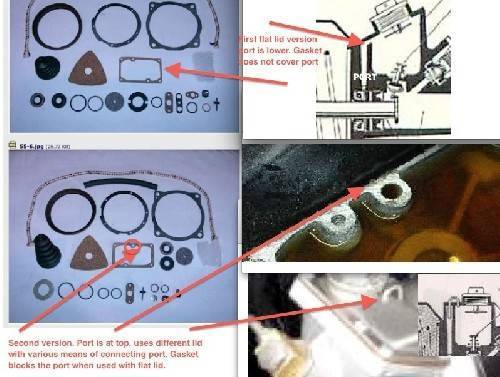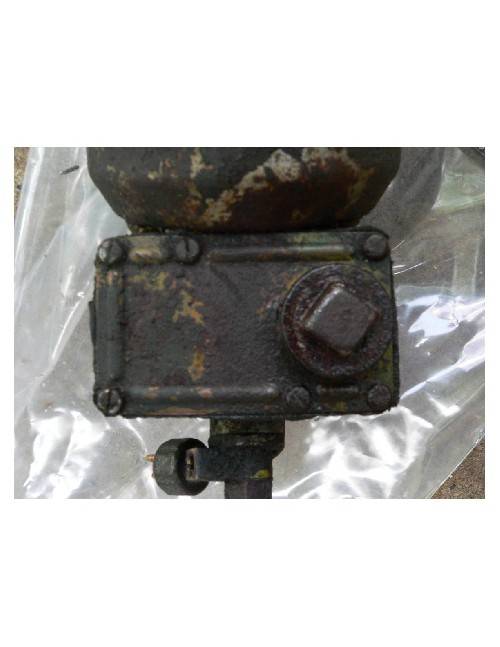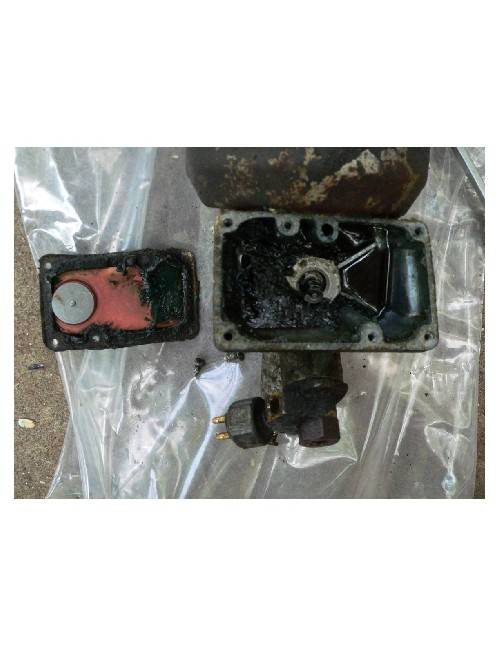|
Re: Easamatic Rebuild Sources
|
||||
|---|---|---|---|---|
|
Home away from home

|
The "smoke" phenomenon has to be related to the vacuum side, as near as I can tell from several sources. I believe the only way that the brake fluid can get sucked into the intake is through the vacuum side. It has to get there before it can get to the vacuum hose leading to the intake, right? And the only way I can see into the vacuum side is through the seals around the hydraulic piston.
Why it happens suddenly is beyond me. If it was due to a pitted piston, you would think it would be gradual. Seals might "blow out" I suppose, but I have had this happen sporadically... sometimes going quite a while with no smoke, no sudden loss of fluid, and with brakes working. Then, all of a sudden, big clouds of smoke and no brakes. After this happens, there is little or no fluid left in the MC reservoir. There is a kind of check valve next to the carburetor inlet that I suppose could malfunction somehow, but I don't see how this would be able to cause evacuation of fluid. If it stuck closed, it would just disable vacuum assist. Once again, I wish my dad were alive to report on how he fixed ours, because the exact situation that Dennis50 described happened to our '55 400, which my dad fixed and which worked flawlessly ever after. (I was in the back seat and saw the smoke, my mom was in the front seat, and I don't think she appreciated the experience much, either.) I am getting my (original as far as I know) '54 Easamatic BTV rebuilt, and will ask for a detailed report of what it looked like inside. The car has about 80K on the odo. The brakes had obviously been neglected prior to when I got the car last fall. I'm beginning to suspect that there may need to be TWO things that have to happen at the same time to create the "perfect storm" of sudden, complete brake failure. That's just a guess, though.
Posted on: 2013/8/6 21:13
|
|||
|
Guy
[b]Not an Expert[/ |
||||
|
||||
|
Re: Easamatic Rebuild Sources
|
||||
|---|---|---|---|---|
|
Home away from home

|
Quote:
LOOKING AT LIDS FOR BTV I spent part of the morning disconnecting the vaccum lines and plugging them on my Easamatic system. It's easiest, I think, to just disconnect the line at the intake manifold fitting, plug it, and cover the end of the fitting with a piece of hose with a bolt in the end. (Time-honored tradition remembered well from disabling various vacuum lines on the old "smogger" cars of the 80's) ANYwhoo, I also checked around to see what kind of MC Reservoir Cover I had. I really can't tell without pics of each style "original flat" or "new style." The cover has some raised portions between the screws, but all in all looks pretty flat. I'd take a pic but, as you know, the steering shaft all but obliterates the view of the cover, so everything I've done is mostly through "feel." If I knew for sure if I had the oldstyle "inside" vent as opposed to the external vent, I could have my rebuilder double-check this to make sure the gasket clears. Sorry to be a pain with the questions, but I just want it done right the first time. Maybe I'm wringing my hands a bit too much, but it might just improve the odds. BTW, driving with vaccum lines disconnected is very tricky. You often have t pump the brakes, even to get a reluctant stop. (I'm sure there is some air in my lines as well, complicating this.) And you need to be ready to use the emergency brake at all times, especially when coming to a full stop. (Having a manual transmission helps a lot. I only did this to be able to get the car to the shop several blocks away, where they will perform the Easadectomy this week. Hope someone can post clear pictures of each of the two different covers. I really appreciate it. HH56's original gasket photo: REALLY HELPFUL. I just need detailed lid shots.
Posted on: 2013/8/11 12:27
|
|||
|
Guy
[b]Not an Expert[/ |
||||
|
||||
|
Re: Easamatic Rebuild Sources
|
||||
|---|---|---|---|---|
|
Forum Ambassador
|
When you remove your unit to send it off, take the lid off and look. It's only 6 screws. When you look at the reservoir, if the port opening is lower than the lid mounting surface, it does not need anything more.
If the casting around the port opening is flush with the surface the lid rests on like in the photo, it needs some kind of accommodation. That might be a different lid or cutting away a bit of the gasket or reversing gasket 180 degrees -- anything to allow the port to have some kind of opening into the reservoir so the Packard flat lid doesn't block it. You say you might have a raised surface between the screws. That was one of the methods used in some later stamped lids. Perhaps your unit was rebuilt or exchanged somewhere in the car's history. If there is a sort of rounded channel on the bottom of the lid -- or anything else which is over the port yet allows it to not be completely blocked off to the rest of the reservoir, then you are OK. If your lid is the one Packard typically used -- an approx 1/8" thick plate with the bottom surface being absolutely flat, then you need to do something.
Posted on: 2013/8/11 13:45
|
|||
|
Howard
|
||||
|
||||
|
Re: Easamatic Rebuild Sources
|
||||
|---|---|---|---|---|
|
Home away from home

|
HH56,
Thanks for your, as always, prompt reply. I felt around the edges of the lid and found no protuberance that would indicate an external vent. I'm pretty sure mine is vented from inside the reservoir. What do I have to do about this? I think warning the rebuilder to make sure the gasket clears that internal vent should do the trick. But is there anything else? Thanks for the thorough counsel on this.
Posted on: 2013/8/11 18:14
|
|||
|
Guy
[b]Not an Expert[/ |
||||
|
||||
|
Re: Easamatic Rebuild Sources
|
||||
|---|---|---|---|---|
|
Forum Ambassador
|
There is nothing you can see or feel from the outside to tell the difference in ports on those with a Packard lid. You have to remove the lid and look.
If he is a good rebuilder, nothing should need to be said. You can mention there were issues belatedly found with the Packard lid blocking the port on some units and you don't know if yours was one of them. I shouldn't think there is a need to go into great detail. Just ask him to make sure the port is open on yours. If he questions the issue, mention the gasket. If he doesn't know immediately what you are talking about, I'd look elsewhere. That is about all you can do.
Posted on: 2013/8/11 18:43
|
|||
|
Howard
|
||||
|
||||
|
Re: Easamatic Rebuild Sources
|
||||
|---|---|---|---|---|
|
Home away from home

|
I will be sure to check the lid and gasket before I send it out for the rebuild. It'll be interesting to see what it looks like in there. Undoubtedly, it's going to need new seals for the hydraulic piston as well, and maybe a refurbished piston, but that all remains to be seen.
Posted on: 2013/8/11 21:01
|
|||
|
Guy
[b]Not an Expert[/ |
||||
|
||||
|
Re: Easamatic Rebuild Sources
|
||||
|---|---|---|---|---|
|
Home away from home

|
Well here are the reservoir pics, cover on and cover off. Note that the cover gasket was completely covering the relief port. You can see the part of the gasket that was over it is bellied out. Also, note the remarkable amount of crud in the reservoir! I'm almost tempted to clean it out, cut a new gasket that does not cover the port, and try 'er again. But I know I'll catch hell if I don't get it rebuilt.
Posted on: 2013/8/12 23:03
|
|||
|
Guy
[b]Not an Expert[/ |
||||
|
||||
|
Re: Easamatic Rebuild Sources
|
||||
|---|---|---|---|---|
|
Home away from home
|
The relief port is not blocked by the gasket as it vents into the embossed portion of the cover and any bypassing fluid passes between the embossing and the and the unsupported inner edge of the gasket and back into the reservoir.
Your unit has been bypassing quite a lot judging by the washed clean surface of the underside of the lid adjacent to the relief port. Any significant amount of bypassing means that the inner piston seal is shot. The relief port was a safety feature on two points: If the inner seal failed, the fluid made its way back to the reservoir. If the the outer seal failed, vacuum leaking past that outer seal could draw air from above the fluid level in the reservoir. Complete failure and rapid fluid loss occurs when both the inner and outer seal have failed and the vacuum side will drink up anything that the fluid side happens to leak. The problem with blocking the relief port only comes when the the cover is dead flat with no embossing. Can't remember just the moment which units had flat covers, but it hardly matters as these units have been mixed and matched and swapped for so long. If you build one with a flat cover you have to notch the gasket. I notice that all Kanter's kits come with notched gaskets which I applaud.
Posted on: 2013/8/13 5:20
|
|||
|
||||
|
Re: Easamatic Rebuild Sources
|
||||
|---|---|---|---|---|
|
Home away from home

|
The inner fluid seal should not leak anymore than ANY other seal should leak such as wheel cylinders, calipers or any other master cylinder design over the last 70 years. Which means ZERO leakage, as in NONE.
Therefore the outer vacuum seal MUST get receive some tiny amount of lubrication from somewhere. I contend it gets that lube from the 'relief' port. And that is the SOLE purpose of the 'relief' port. Perhaps my above claim is more or less just academic. Well maybe.
Posted on: 2013/8/13 6:51
|
|||
|
VAPOR LOCK demystified: See paragraph SEVEN of PMCC documentaion as listed in post #11 of the following thread:f
https://packardinfo.com/xoops/html/modules/newbb/viewtopic.php?topic_id=7245 |
||||
|
||||

 (64.03 KB)
(64.03 KB)









